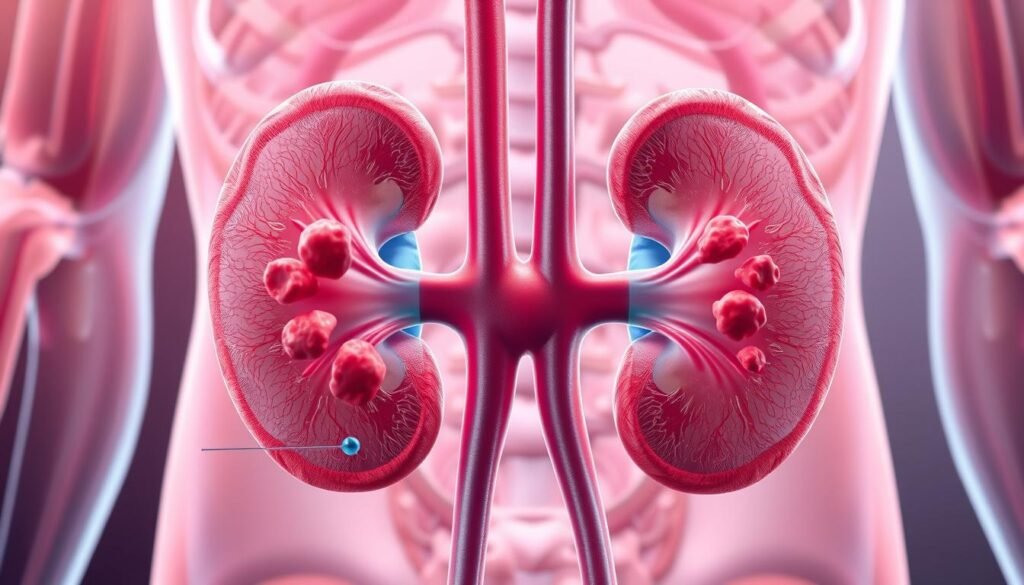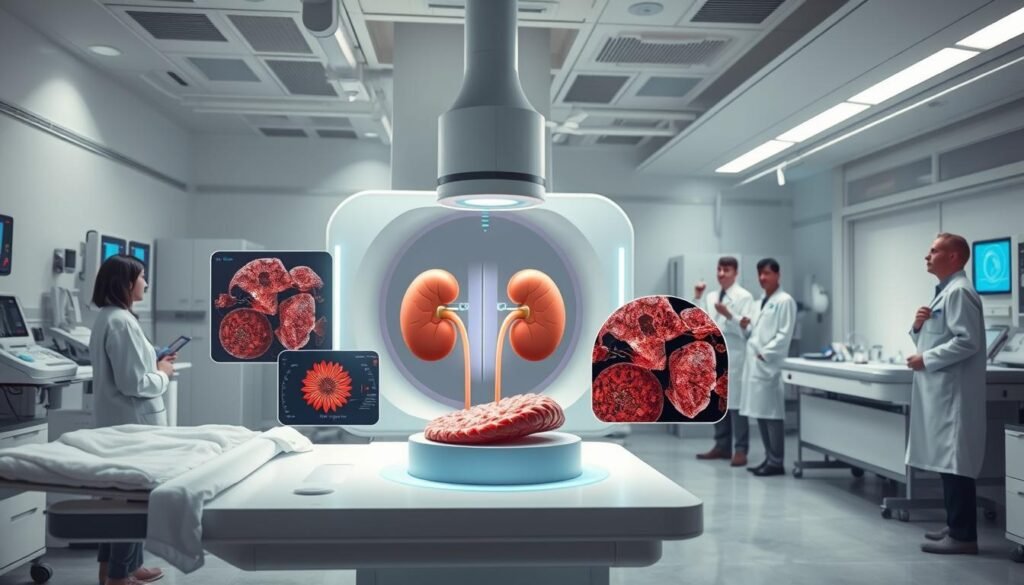About 12.6% of lung cancer patients might see their cancer spread to the kidneys. This fact shows how complex lung cancer is, a major cause of cancer deaths in the US. When it spreads, it can reach many organs, with the kidneys being a less common but important target. Knowing the symptoms of this spread is key for early detection and treatment. We will explore the signs of cancer moving to the kidneys.
Key Takeaways
- Renal metastases from lung cancer occur in approximately 12.6% of cases.
- Most patients with kidney metastasis from lung cancer have poorly differentiated tumors.
- Males represent all documented cases of lung cancer metastasis to the kidneys.
- Survival rates may vary significantly based on the type of lung cancer and the stage at initial diagnosis.
- Early identification of symptoms can improve treatment outcomes and patient management.
Understanding Lung Cancer and Its Types
Lung cancer splits into two main kinds: small cell lung cancer (SCLC) and non-small cell lung cancer (NSCLC). How doctors diagnose and treat the disease varies by type.
Non-small cell lung cancer makes up about 85% of cases. Adenocarcinoma is the most common form, often found in non-smokers and young women. Squamous cell carcinoma, related to smoking, is usually in the lung’s central parts.
Small cell lung cancer represents 10% to 15% of lung cancers. It’s aggressive and spreads fast, mainly in smokers. Patients with SCLC have a tougher fight because it moves quickly to other areas.
Other rare lung tumor types exist. For example, mesothelioma, from asbestos, is about 5% of cases. Carcinoid tumors are less than 5% but vary in how fast they grow.
Knowing the different lung cancer types helps in making specific treatment plans. It’s essential to identify the type accurately to manage the disease well and help patients more effectively.
What is Metastasis?
Metastasis is when cancer cells spread from the original tumor to other body parts. It’s key to understanding cancer’s impact. It happens through invading nearby tissues, moving into blood vessels, and traveling through the lymph system.
These cells can then form new tumors elsewhere, called metastatic disease. In renal cell carcinoma, 25-30% of patients have metastatic disease when diagnosed. Less than 1% of lung cancer patients see it spread to the kidneys. Yet, this rare spread changes treatment approaches greatly.
Knowing about metastasis helps doctors track lung cancer’s movement. It shows how the disease can reach organs like the kidneys. Doctors use this info to plan treatments that control symptoms and slow the cancer. For more on managing metastatic disease, check out this helpful link.
Common Sites of Lung Cancer Metastasis
Lung cancer can spread to different parts of the body. This makes treating it quite complex. The bones, brain, liver, and adrenal glands are places it often reaches. Cases involving the kidneys are less common but still important to know about. Promptly spotting these patterns is key to helping patients.
About 12.6% of lung cancer sufferers might see their cancer spread to the kidneys. Small cell lung cancer (SCLC) makes up 15% of cases. The other 85% is non-small cell lung cancer (NSCLC). How and where the cancer spreads can vary greatly by its type. SCLC often spreads early on whereas NSCLC might take longer to do so.
Looking at those with kidney involvement, they were all men around 62 years old. It took roughly 15 months after lung cancer was found for it to reach the kidneys. The left kidney was usually affected more than the right. The tumors found were about 3.9 cm big. Half of these cases also had cancer in the lymph nodes, signaling worse cancer behavior.
People with lung cancer that has reached the kidneys generally don’t live long, especially if cancer has spread to multiple places. Life expectancy after such a diagnosis can range widely, from 7 to 55 months. This shows how unpredictable living with this condition can be.
Knowing where lung cancer commonly spreads helps doctors watch for and manage these challenges better. It ensures patients get the care they need, considering their specific health situation.
Signs of Lung Cancer Metastasis to the Kidneys
Spotting kidney metastasis signs can be tough. They often look like other health issues. People might see blood in their urine, known as hematuria, and feel flank pain.
Other common symptoms include feeling very tired, losing weight, and sweating at night. These signs can suggest renal metastasis symptoms. It’s key to keep an eye out for any changes.
The kidneys filter blood, so urinary changes or kidney function shifts might happen. Some might find they have unexplained anemia. This can make them feel worn out or short of breath. These are considered kidney cancer symptoms since they affect blood flow.
Understanding these signs is critical for early detection and treatment of kidney cancer. For more information on lung cancer spread, check this resource.

Lung Cancer Metastasis to Kidney Symptoms
Lung cancer spreading to the kidney shows several symptoms. Knowing these is key for quick medical help. Spotting symptoms early helps manage them better. If you notice strange signs, see a doctor right away.
Common Symptoms to Watch For
The usual signs of lung cancer moving to the kidneys include:
- Hematuria: Blood in your urine is a big warning sign. It often means there might be kidney damage.
- Flank pain: Pain on the side of your body could be a kidney problem. It shows where the issue is.
- General malaise: Feeling sick in general is common.
- Weight loss: Losing a lot of weight without trying is a sign.
- Unexplained fevers: If you have fevers for no reason, check it out.
Less Frequent Symptoms
Some symptoms don’t happen often but can as the disease gets worse. These include:
- Symptoms like persistent cough or chest pain come from the main lung cancer.
- Decreased kidney function can cause abdominal swelling or even kidney failure.
Watching for these symptoms helps with lung and kidney health care. To learn more about kidney cancer symptoms, go here. Knowing how lung cancer spreads, like to the kidneys, makes treatments better. For signs of lung cancer, visit this page.
Distinguishing Between Primary Kidney Cancer and Kidney Metastasis
Understanding the differences between primary and metastatic kidney cancer is key. Primary kidney cancer, mainly renal cell carcinoma, is a top kidney cancer type in adults. It makes up about 3% of all cancers, showing various histologic subtypes. Renal cell carcinoma has special imaging features. These features help tell it apart from metastasis lesions.
Doctors use imaging studies and patient history to identify primary kidney cancer from metastasis. Common tools include CT scans and MRI. They offer insights into the tumor’s size, shape, and traits, helping in diagnosis.
To confirm a diagnosis, a biopsy is often needed. Examining biopsy samples is crucial for recognizing cellular features of renal cell carcinoma. Pathologists look for markers like TTF-1 to find lung cancer metastasis. These steps are vital in choosing the right treatment.
Recognizing these differences is essential for successful treatment and prognosis. Choosing the correct treatment depends on if the cancer is primary or metastatic. This distinction is very important.
| Feature | Primary Kidney Cancer (Renal Cell Carcinoma) | Metastatic Kidney Cancer |
|---|---|---|
| Incidence | 3% of all cancers | Varies, common in advanced lung cancer |
| Imaging Characteristics | Distinct features, often homogeneous | May show irregularities or multiple lesions |
| Biopsy Requirement | Histological examination required | Histological evaluation plus immunohistochemistry |
| Main Treatment Options | Surgery, targeted therapies | Varies, may include systemic therapies |
Diagnosis of Kidney Metastasis from Lung Cancer
To start, doctors use imaging techniques to see if kidney metastasis is present. The CT scan is particularly effective for spotting unusual renal masses. These tests are vital for identifying signs of the disease spreading.
After finding a renal mass, a biopsy is crucial. It confirms if lung cancer has spread by examining the tissue. Knowing the exact type of lung cancer helps doctors choose the best treatment plan.
Most people found with kidney metastases from lung cancer are men around 62 years old. Research shows lung adenocarcinoma often leads to these metastases. This underscores the importance of clear kidney metastasis diagnosis procedures.
The time until kidney metastasis appears depends on the lung cancer type. Small cell and squamous lung cancer progress more quickly than adenocarcinoma. This shows the cancers behave differently. Also, imaging might mistake cancer for benign kidney tumors, making a biopsy essential for correct treatment.
To better understand kidney metastasis from lung cancer, more research and improved diagnostics are needed. For more on cancer classification, check out the TNM system. It provides valuable information for picking the right treatment approach.
Treatment Options for Kidney Metastasis
Treatment for kidney metastasis from advanced lung cancer aims to manage symptoms and improve life quality. The right treatment depends on cancer’s stage, metastasis locations, and patient health.
Surgical Interventions
Surgery plays a key role in treating kidney metastasis. When there’s a single kidney lesion, doctors might suggest removing it. This is especially true if it’s affecting the kidney’s function greatly. Taking out tumors can ease symptoms and might help patients live longer.
Medical Management
Medical treatments include chemotherapy and targeted therapies that match the lung cancer type. Immunotherapy has also improved outcomes for metastatic kidney cancer. Clinical trials offer innovative treatment possibilities. While treatments can have side effects, understanding them helps in better care for patients.

| Treatment Type | Description | Considerations |
|---|---|---|
| Surgery | Nephrectomy for solitary lesions or significant renal function compromise | Best for localized tumors with no widespread metastasis |
| Chemotherapy | Systemic treatment tailored based on lung cancer subtype | Less effective for renal cell carcinoma; focus on lung cancer treatments |
| Immunotherapy | Targets specific aspects of cancer cells to enhance immune response | Promising results for metastatic renal cell carcinoma |
| Radiation Therapy | Used to shrink tumors and manage symptoms | Exploratory in managing metastatic kidney cancer; effective in some cases |
Prognosis and Survival Rates
Lung cancer spreading to the kidneys often leads to a poor outlook. Survival rates fall as the cancer affects more organs. For example, only 17% of people with advanced kidney cancer go on living for five years after diagnosis. This shows how serious the condition is when it spreads.
The chances of survival depend on the lung cancer type, the person’s health, and how well they respond to treatment. People with kidney cancer found early have a 93% chance of living five years or more. Early detection and treatment are crucial for better outcomes. It’s important to talk to doctors for a personal survival rate and treatment plan.
Survival rates for kidney cancer vary widely by stage. About 75% of those with cancer spread locally survive five years or more. But, survival chances decrease as the cancer advances. Early and ongoing care is key to living longer.
Knowing the survival rates for kidney cancer helps in planning the right treatment. People with lung cancer in the kidneys should get regular check-ups and discuss their outlook with doctors. For more on survival rates, here’s a helpful link.
Living with Advanced Lung Cancer
Patients with advanced lung cancer face many challenges. It’s vital to have a support network for cancer patients. Support with emotions, managing pain, and changing lifestyles helps improve their lives.
Joining support groups lets patients connect with others in similar situations. These groups share knowledge and offer a sense of belonging. Also, eating well is crucial, so nutritional advice is key to keep patients healthy.
Palliative care focuses on easing symptoms and improving quality of life. Talking with cancer doctors and health teams is critical. This way, patients can get the right help for their symptoms and treatment effects.

Looking after both physical and mental health is essential in advanced lung cancer management. Patients may feel very tired, lose weight, and go through emotional changes. Caregivers are important too. They need support as they help their loved ones.
| Aspects of Care | Focus Areas | Goals |
|---|---|---|
| Emotional Support | Support groups, counseling | Reduce feelings of isolation |
| Pain Management | Medications, therapy | Enhance comfort levels |
| Nutritional Counseling | Dietary plans | Improve energy and strength |
| Palliative Care | Symptom management | Maximize quality of life |
By focusing on these areas, patients and families can better deal with advanced lung cancer. Working together helps create a complete care plan. It meets the needs of each individual as they move forward.
Conclusion
Understanding the signs of lung cancer spreading to the kidneys is key for quick action and managing it well. It helps patients and doctors spot worrying signs early. This quick spotting can mean faster help and better outcomes.
Lung tumors are often behind kidney metastases, making it important to stay alert for any health changes.
It’s vital to learn about kidney metastasis too. Since lung cancer often spreads to the kidneys, knowing more can help people work better with their doctors. Talking about symptoms and getting tests like biopsies or scans is crucial for good care.
Hope lies in the future with new research and better treatments for lung cancer and its spread. Focusing more on knowing about lung cancer and taking care of our health could lead to higher survival rates. It could also lead to better ways to face this complex illness.